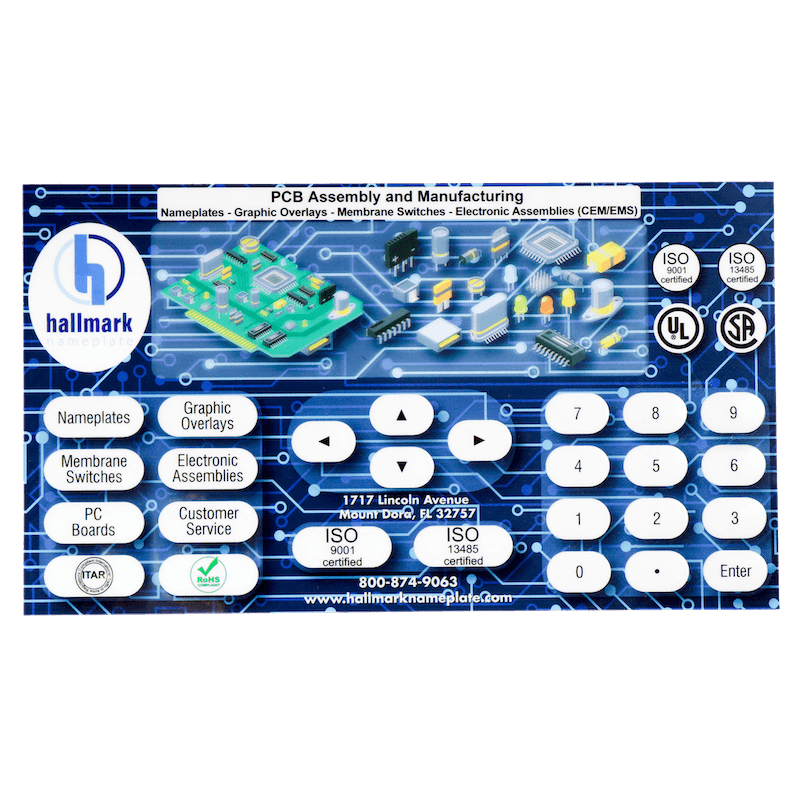How Membrane Switch Technology is Revolutionizing User Interfaces
How Membrane Switch Technology is Revolutionizing User Interfaces
Blog Article
Recognizing Membrane Switches Over: The Secret to Long Lasting and Reliable Controls

What Are Membrane Switches?
Membrane buttons are an advanced service in the realm of interface modern technology, integrating performance and style flawlessly. These devices function as an interface between customers and digital systems, integrating numerous parts right into a compact style. Commonly built from adaptable, slim layers of products, membrane buttons are created to react to touch, making it possible for individuals to interact with machinery and digital tools properly.
The main aspects of a membrane layer switch include a printed circuit layer, graphic overlay, and a spacer layer that avoids unplanned activation. The graphic overlay can be tailored to show brand identity or user preferences, enhancing aesthetic appeals while ensuring functionality. Membrane buttons are typically made use of in various applications, including clinical devices, consumer electronics, and commercial devices, owing to their toughness and resistance to ecological factors such as dampness and dust.
Among the key advantages of membrane layer switches is their capability to stand up to wear and tear, making them optimal for high-traffic settings. Furthermore, they are light-weight and call for minimal space, permitting innovative designs in product advancement. Overall, membrane switches over stand for a effective and practical option for contemporary digital user interfaces, weding innovation with user-centric layout concepts.
Exactly How Membrane Layer Changes Job
The operation of membrane switches over hinges on a straightforward yet reliable system that translates user input right into electronic signals. When a customer presses the button, the leading layer deforms, enabling a conductive aspect in the circuit layer to make contact with a matching conductive pad on the underside of the graphic overlay.
The design of membrane layer buttons can vary, but they frequently include domes or tactile elements to offer responses to the customer, improving the total experience - membrane switch. The materials utilized in membrane buttons, such as polyester or polycarbonate, add to their toughness and resistance to ecological factors, consisting of moisture and dust. Additionally, the printed circuits are typically encapsulated, which safeguards them from damage gradually.
Benefits of Membrane Buttons

In addition, membrane layer switches are recognized for their sturdiness. Built from durable materials, they useful link are immune to dirt, dampness, and physical wear, which considerably expands their lifespan contrasted to conventional mechanical buttons. This durability makes them especially suitable Visit Website for high-traffic environments and applications calling for longevity.
Another considerable benefit is the simplicity of cleansing and upkeep. The smooth surface of membrane layer switches over decreases dirt buildup and is frequently unsusceptible spills, making them perfect for settings that call for constant sanitization.
Moreover, membrane switches use a structured account, bring about a thinner design that can be integrated right into different devices without including mass. This attribute not just improves the visual appeal but additionally adds to a much more ergonomic item style.
Applications of Membrane Switches
User-friendly and versatile, membrane layer buttons locate applications across a variety of sectors, including medical devices, customer electronics, and commercial equipment. In the medical field, these switches are integral to devices such as diagnostic tools, client tracking systems, and infusion pumps, where dependability and convenience of cleaning are vital. Their capacity to hold up against rough atmospheres and preserve capability makes them optimal for such applications.

In consumer electronics, membrane layer buttons are made use of in products like microwaves, cleaning devices, and remote controls - membrane switch. Their smooth style permits instinctive interface, improving the overall customer experience while offering toughness and resistance to damage
Commercial tools likewise profits from membrane switches, particularly in control panels for machinery and automation systems. These buttons use defense against dust and dampness, guaranteeing regular performance in challenging atmospheres. Moreover, their customizable features allow manufacturers to tailor them to certain operational requirements, improving effectiveness and capability.
Picking the Right Membrane Switch Over
When selecting a membrane switch, it is vital to take into go to my site consideration various factors that influence efficiency and suitability for specific applications. The primary considerations consist of ecological problems, responsive feedback, longevity, and design specifications.
First, assess the operating setting; buttons revealed to wetness, chemicals, or severe temperatures require details products to guarantee long life and capability. Next, assess the demand for responsive responses. Depending on customer interaction, some applications might take advantage of a tactile reaction to verify activation, while others may favor a non-tactile layout for visual reasons.
Toughness is another important element; membrane switches ought to be created to withstand constant use, influences, and abrasion. Make sure the chosen switch can withstand the expected lifecycle, particularly in high-usage scenarios.

Conclusion
In final thought, membrane layer switches over serve as crucial components in the design of resilient and dependable control systems across different industries. The flexibility of membrane switches over allows for customized remedies that fulfill details operational demands, strengthening their importance in modern technology.
Membrane switches over represent a vital facet of modern-day user interface layout, blending performance with strength in various applications.Membrane layer switches are a sophisticated remedy in the world of individual interface technology, integrating performance and design perfectly. Typically built from versatile, slim layers of materials, membrane layer switches are made to respond to touch, enabling users to communicate with machinery and electronic devices successfully.
The layout of membrane buttons can differ, but they usually include domes or responsive components to supply feedback to the customer, improving the total experience.In verdict, membrane layer switches over serve as vital components in the layout of reputable and resilient control systems across various sectors.
Report this page